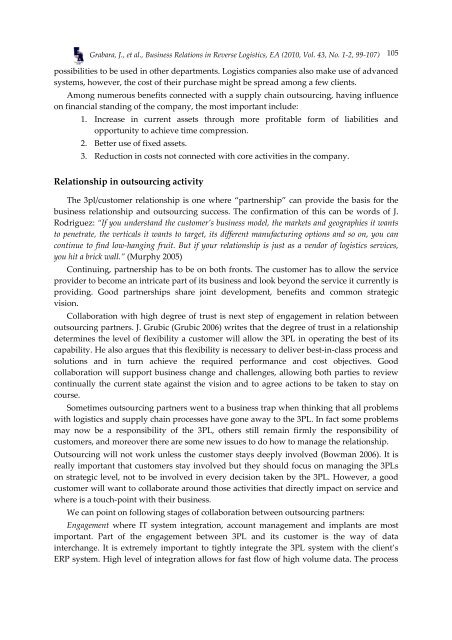Twice a Year Scientific Journal
Twice a Year Scientific Journal
Twice a Year Scientific Journal
Create successful ePaper yourself
Turn your PDF publications into a flip-book with our unique Google optimized e-Paper software.
Grabara, J., et al., Business Relations in Reverse Logistics, EA (2010, Vol. 43, No. 1-2, 99-107) 105<br />
possibilities to be used in other departments. Logistics companies also make use of advanced<br />
systems, however, the cost of their purchase might be spread among a few clients.<br />
Among numerous benefits connected with a supply chain outsourcing, having influence<br />
on financial standing of the company, the most important include:<br />
1. Increase in current assets through more profitable form of liabilities and<br />
opportunity to achieve time compression.<br />
2. Better use of fixed assets.<br />
3. Reduction in costs not connected with core activities in the company.<br />
Relationship in outsourcing activity<br />
The 3pl/customer relationship is one where “partnership” can provide the basis for the<br />
business relationship and outsourcing success. The confirmation of this can be words of J.<br />
Rodriguez: “If you understand the customer’s business model, the markets and geographies it wants<br />
to penetrate, the verticals it wants to target, its different manufacturing options and so on, you can<br />
continue to find low-hanging fruit. But if your relationship is just as a vendor of logistics services,<br />
you hit a brick wall.” (Murphy 2005)<br />
Continuing, partnership has to be on both fronts. The customer has to allow the service<br />
provider to become an intricate part of its business and look beyond the service it currently is<br />
providing. Good partnerships share joint development, benefits and common strategic<br />
vision.<br />
Collaboration with high degree of trust is next step of engagement in relation between<br />
outsourcing partners. J. Grubic (Grubic 2006) writes that the degree of trust in a relationship<br />
determines the level of flexibility a customer will allow the 3PL in operating the best of its<br />
capability. He also argues that this flexibility is necessary to deliver best-in-class process and<br />
solutions and in turn achieve the required performance and cost objectives. Good<br />
collaboration will support business change and challenges, allowing both parties to review<br />
continually the current state against the vision and to agree actions to be taken to stay on<br />
course.<br />
Sometimes outsourcing partners went to a business trap when thinking that all problems<br />
with logistics and supply chain processes have gone away to the 3PL. In fact some problems<br />
may now be a responsibility of the 3PL, others still remain firmly the responsibility of<br />
customers, and moreover there are some new issues to do how to manage the relationship.<br />
Outsourcing will not work unless the customer stays deeply involved (Bowman 2006). It is<br />
really important that customers stay involved but they should focus on managing the 3PLs<br />
on strategic level, not to be involved in every decision taken by the 3PL. However, a good<br />
customer will want to collaborate around those activities that directly impact on service and<br />
where is a touch-point with their business.<br />
We can point on following stages of collaboration between outsourcing partners:<br />
Engagement where IT system integration, account management and implants are most<br />
important. Part of the engagement between 3PL and its customer is the way of data<br />
interchange. It is extremely important to tightly integrate the 3PL system with the client’s<br />
ERP system. High level of integration allows for fast flow of high volume data. The process
















